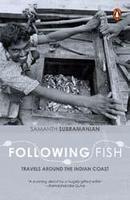“Following Fish” by Samanth Subramanian is one of those rare English books published from India that are not banal attempts at aping the success of the last block-buster book or lame attempts at becoming a “published author”. It is a travelogue and a food-guide that is very well-written and has also been very well-received, hopefully encouraging others to write good non-fiction books of their own.
The book is a collection of nine essays that describe the author's travels through the coast of India in pursuit of the ways in which fish are caught and prepared, as well as the lives of the people who catch the fish. He travels to West Bengal, Andhra Pradesh, Tamil Nadu, Kerala, Karnataka, Goa, Maharashtra and Gujarat in his quest, each of which features in an essay (except for Goa, which features in two). The author puts life into these essays by displaying a keen eye for details, a great sense of humor and a flair for the English language. He seems to have charmingly few hang-ups that allow him to get close to his subjects without alienating them.
The essays are wide-ranging in the topics they cover, but are all related in one way or the other to fish. These include the preparation of the famed hilsa (or ilish) in Kolkata, the purported cure for asthma that is delivered by shoving a live medicine-carrying fish down patients' throats in Hyderabad, the toddy shops of Kerala, the pursuit of the sailfish, one of the fastest fish in the oceans, somewhere near Goa and boat-building in Gujarat. Each essay is largely self-contained and with a distinctive feel of its own, making it easy to savor this book in easily-digestible pieces.
It is not very clear just why the author sets out on these journeys, especially since he seems to have taken a dislike to eating fish as a young boy coming from a vegetarian family, but he does show a remarkable passion for his mission and an amazing perseverance. He has a curious penchant for noting brand names (a Mirinda bottle holding oil for a church's lamps, empty Servo bottles used as flotation devices, etc.). I was mildly disappointed that the author does not mention having tasted matthi (sardine) in Kerala, especially since most of the people who have tasted it seem to fall in love with it as far as I have seen, despite its abundance of slender bones that are hard to separate from its flesh. Finally it would be nice to have a list of fish mentioned in the book along with their local names and a sketch or a photograph, for people who are not well-versed in the different types of fish commonly eaten in our country.
Even if you have never tasted fish, these essays make for very interesting reads since they are as much about people and places as about fish. If you love fish, then you owe it to yourself to read this fantastic little book that has just under 170 pages in all.
